0.目录
1.线性表的链式存储结构
2.单链表的具体实现
3.顺序表和单链表的对比分析
4.小结
1.线性表的链式存储结构
顺序存储结构线性表的最大问题是:
- 插入和删除需要移动大量的元素!如何解决?
链式存储的定义:
- 为了表示每个数据元素与其直接后继元素之间的逻辑关系;数据元素除了存储本身的信息外,还需要存储其直接后继的信息。

链式存储逻辑结构:
- 基于链式存储结构的线性表中,每个结点都包含数据域和指针域
- 数据域:存储数据元素本身
- 指针域:存储相邻结点的地址

专业术语的统一:
- 顺序表
- 基于顺序存储结构的线性表
- 链表
- 基于链式存储机构的线性表
- 单链表:每个结点只包含直接后继的地址信息
- 循环链表:单链表中的最后一个结点的直接后继为第一个结点
- 双向链表:单链表中的结点包含直接前驱和后继的地址信息
- 基于链式存储机构的线性表
链表中的基本概念:
- 头结点
- 链表中的辅助结点,包含指向第一个数据元素的指针
- 数据结点
- 链表中代表数据元素的结点,表现形式为:( 数据元素,地址 )
- 尾结点
- 链表中的最后一个数据结点,包含的地址信息为空
单链表中的结点定义:
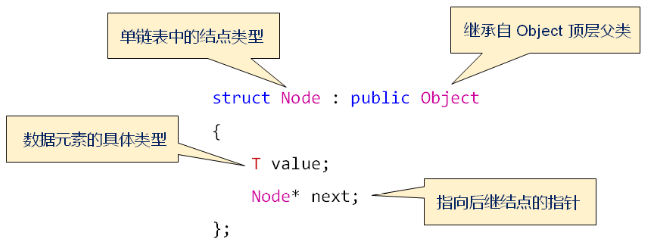
单链表中的内部结构:

头结点在单链表中的意义是:辅助数据元素的定位,方便插入和删除操作;因此,头结点不存储实际的数据元素。
在目标位置处插入数据元素:
- 从头结点开始,通过current指针定位到目标位置
- 从堆空间申请新的Node结点
- 执行操作:
node->value = e;node->next = current->next;current->next = node;
在目标位置处删除数据元素:
- 从头结点开始,通过current指针定位到目标位置
- 使用toDel指针指向需要删除的结点
- 执行操作:
toDel = current->next;current->next = toDel->next;delete toDel;
2.单链表的具体实现
本节目标:
- 完成链式存储结构线性表的实现
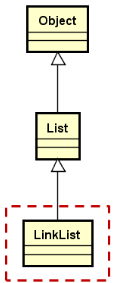
LinkList 设计要点:
- 类模板,通过头结点访问后继结点
- 定义内部结点类型Node,用于描述数据域和指针域
- 实现线性表的关键操作( 增,删,查,等 )
LinkList的定义:
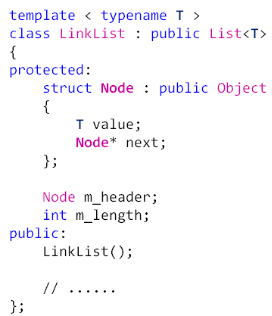
链表的实现 LinkList.h:
#ifndef LINKLIST_H
#define LINKLIST_H
#include "List.h"
#include "Exception.h"
namespace StLib
{
template <typename T>
class LinkList : public List<T>
{
protected:
struct Node : public Object
{
T value;
Node* next;
};
mutable Node m_header;
int m_length;
public:
LinkList()
{
m_header.next = NULL;
m_length = 0;
}
bool insert(const T& e)
{
return insert(m_length, e);
}
bool insert(int i, const T& e)
{
bool ret = ((0 <= i) && (i <= m_length));
if( ret )
{
Node* node = new Node();
if( node != NULL )
{
Node* current = &m_header;
for(int p=0; p<i; p++)
{
current = current->next;
}
node->value = e;
node->next = current->next;
current->next = node;
m_length++;
}
else
{
THROW_EXCEPTION(NoEnoughMemoryException, "No memory to insert new element ...");
}
}
return ret;
}
bool remove(int i)
{
bool ret = ((0 <= i) && (i < m_length));
if( ret )
{
Node* current = &m_header;
for(int p=0; p<i; p++)
{
current = current->next;
}
Node* toDel = current->next;
current->next = toDel->next;
delete toDel;
m_length--;
}
return ret;
}
bool set(int i, const T& e)
{
bool ret = ((0 <= i) && (i < m_length));
if( ret )
{
Node* current = &m_header;
for(int p=0; p<i; p++)
{
current = current->next;
}
current->next->value = e;
}
return ret;
}
T get(int i) const
{
T ret;
if( get(i, ret) )
{
return ret;
}
else
{
THROW_EXCEPTION(IndexOutOfBoundsException, "Invalid parameter i to get element ...");
}
return ret;
}
bool get(int i, T& e) const
{
bool ret = ((0 <= i) && (i < m_length));
if( ret )
{
Node* current = &m_header;
for(int p=0; p<i; p++)
{
current = current->next;
}
e = current->next->value;
}
return ret;
}
int length() const
{
return m_length;
}
void clear()
{
while ( m_header.next )
{
Node* toDel = m_header.next;
m_header.next = toDel->next;
delete toDel;
}
m_length = 0;
}
~LinkList()
{
clear();
}
};
}
#endif // LINKLIST_H
main.cpp测试
#include <iostream>
#include "LinkList.h"
using namespace std;
using namespace StLib;
int main()
{
LinkList<int> list;
for(int i=0; i<5; i++)
{
list.insert(0, i);
list.set(0, i*i);
}
for(int i=0; i<list.length(); i++)
{
cout << list.get(i) << endl;
}
cout << endl;
list.remove(2);
for(int i=0; i<list.length(); i++)
{
cout << list.get(i) << endl;
}
cout << endl;
list.clear();
for(int i=0; i<list.length(); i++)
{
cout << list.get(i) << endl;
}
return 0;
}
运行结果为:
16
9
4
1
0
16
9
1
0
问题:
- 头结点是否存在隐患?
- 实现代码是否需要优化?
头结点的隐患:
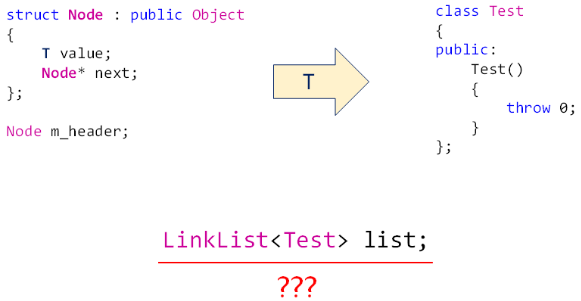
代码优化:
- insert,remove,get,set等操作都涉及元素定位。

代码优化(LinkList.h):
#ifndef LINKLIST_H
#define LINKLIST_H
#include "List.h"
#include "Exception.h"
namespace StLib
{
template <typename T>
class LinkList : public List<T>
{
protected:
struct Node : public Object
{
T value;
Node* next;
};
mutable struct : public Object
{
char reserved[sizeof(T)];
Node* next;
} m_header;
int m_length;
Node* position(int i) const
{
Node* ret = reinterpret_cast<Node*>(&m_header);
for(int p=0; p<i; p++)
{
ret = ret->next;
}
return ret;
}
public:
LinkList()
{
m_header.next = NULL;
m_length = 0;
}
bool insert(const T& e)
{
return insert(m_length, e);
}
bool insert(int i, const T& e)
{
bool ret = ((0 <= i) && (i <= m_length));
if( ret )
{
Node* node = new Node();
if( node != NULL )
{
Node* current = position(i);
node->value = e;
node->next = current->next;
current->next = node;
m_length++;
}
else
{
THROW_EXCEPTION(NoEnoughMemoryException, "No memory to insert new element ...");
}
}
return ret;
}
bool remove(int i)
{
bool ret = ((0 <= i) && (i < m_length));
if( ret )
{
Node* current = position(i);
Node* toDel = current->next;
current->next = toDel->next;
delete toDel;
m_length--;
}
return ret;
}
bool set(int i, const T& e)
{
bool ret = ((0 <= i) && (i < m_length));
if( ret )
{
position(i)->next->value = e;
}
return ret;
}
T get(int i) const
{
T ret;
if( get(i, ret) )
{
return ret;
}
else
{
THROW_EXCEPTION(IndexOutOfBoundsException, "Invalid parameter i to get element ...");
}
return ret;
}
bool get(int i, T& e) const
{
bool ret = ((0 <= i) && (i < m_length));
if( ret )
{
e = position(i)->next->value;
}
return ret;
}
int length() const
{
return m_length;
}
void clear()
{
while ( m_header.next )
{
Node* toDel = m_header.next;
m_header.next = toDel->next;
delete toDel;
}
m_length = 0;
}
~LinkList()
{
clear();
}
};
}
#endif // LINKLIST_H
3.顺序表和单链表的对比分析
问题
- 如何判断某个数据元素是否存在于线性表中?
遗失的操作——find:
- 可以为线性表( List )增加一个查找操作
- int find(const T& e) const;
- 参数:
- 待查找的数据元素
- 返回值:
-
=0:数据元素在线性表中第一次出现的位置
- -1:数据元素不存在
-
- 参数:
数据元素查找示例:

实现查找find函数:
在List.h中加入
virtual int find(const T& e) const = 0;
在SeqList.h中加入
int find(const T& e) const
{
int ret = -1;
for(int i=0; i<m_length; i++)
{
if( m_array[i] == e )
{
ret = i;
break;
}
}
return ret;
}
在LinkList.h中加入
int find(const T& e) const
{
int ret = -1;
int i = 0;
Node* node = m_header.next;
while ( node )
{
if( node->value == e )
{
ret = i;
break;
}
else
{
node = node->next;
i++;
}
}
return ret;
}
但是若用类对象来进行测试,会有严重的bug:
#include <iostream>
#include "LinkList.h"
using namespace std;
using namespace StLib;
class Test
{
int i;
public:
Test(int v = 0)
{
i = v;
}
};
int main()
{
Test t1;
Test t2;
Test t3;
LinkList<Test> list;
return 0;
}
编译错误信息:
error C2678: 二进制“==”: 没有找到接受“Test”类型的左操作数的运算符(或没有可接受的转换)
于是应该在顶层父类Object中实现重载比较操作符
Object.h
bool operator == (const Object& obj);
bool operator != (const Object& obj);
Object.cpp
bool Object::operator == (const Object& obj)
{
return (this == &obj);
}
bool Object::operator != (const Object& obj)
{
return (this != &obj);
}
main.cpp再测试
#include <iostream>
#include "LinkList.h"
using namespace std;
using namespace StLib;
class Test : public Object
{
int i;
public:
Test(int v = 0)
{
i = v;
}
bool operator == (const Test& t)
{
return (i == t.i);
}
};
int main()
{
Test t1(1);
Test t2(2);
Test t3(3);
LinkList<Test> list;
list.insert(t1);
list.insert(t2);
list.insert(t3);
cout << list.find(t2) << endl;
return 0;
}
运行结果为:
1
时间复杂度对比分析:
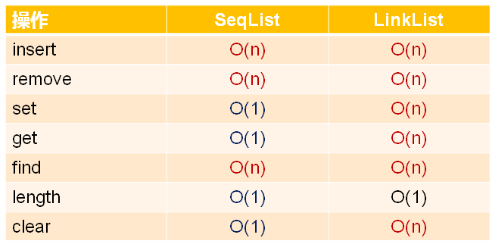
有趣的问题:
- 顺序表的整体时间复杂度比单链表要低,那么单链表还有使用价值吗?
效率的深度分析:
- 实际工程开发中,时间复杂度只是效率的一个参考指标
- 对于内置基础类型,顺序表和单链表的下效率不相上
- 对于自定义类类型,顺序表在效率上低于单链表
- 插入和删除
- 顺序表:涉及大量数据对象的复制操作
- 单链表:只涉及指针操作,效率与数据对象无关
- 数据访问
- 顺序表:随机访问,可直接定位数据对象
- 单链表:顺序访问,必须从头访问数据对象,无法直接定位
工程开发中的选择:
- 顺序表
- 数据元素的类型相对简单,不涉及深拷贝
- 数据元素相对稳定,访问操作远多于插入和删除操作
- 单链表
- 数据元素的类型相对复杂,复制操作相对耗时
- 数据元素不稳定,需要经常插入和删除,访问操作较少
4.小结
- 链表中的数据元素在物理内存中无相邻关系
- 链表中的结点都包含数据域和指针域
- 头结点用于辅助数据元素的定位,方便插入和删除操作
- 插入和删除操作需要保证链表的完整性
- 通过类模板实现链表,包含头结点成员和长度成员
- 定义结点类型,并通过堆中的结点对象构成链式存储
- 为了避免构造错误的隐患,头结点类型需要重定义
- 代码优化是编码完成后必不可少的环节
- 线性表中元素的查找依赖于相等比较操作符( == )
- 顺序表适用于访问需求量较大的场合( 随机访问 )
- 单链表适用于数据元素频繁插入删除的场合( 顺序访问 )
- 当数据类型相对简单时,顺序表和单链表的效率不相上下